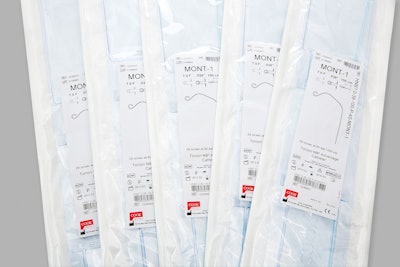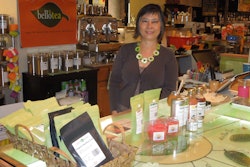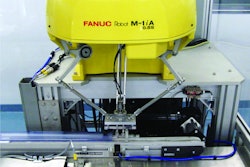When a company purchases packaging equipment, a time is typically determined to calculate a return on investment. When a company invests time and financial resources to meet global identification and track-and-trace efforts, ROI isn’t necessarily measured economically, but in its ability to meet global customer and industry requirements, and to elevate its global competitive position.
That was the case for Cook Medical, a Bloomington, IN-based maker of 16,000 medical device products that are sold within 135 countries. These devices range from minimally invasive products such as needles, wire guides, and catheters to complex implantables such as endovascular grafts for aortic aneurysm repair.
The healthcare organization, which celebrated its 50th anniversary last year, is made up of 10 strategic business units/divisions that include aortic intervention, critical care, endoscopy, interventional radiology, lead management, otolaryngology, peripheral intervention, surgery, urology, and women’s health. Manufacturing is conducted at five locations in the U.S., one in Europe, and one in Australia.
Operating within this worldwide environment helped convince Cook Medical to seek a global solution to better identify, track, and trace its broad product mix, ultimately benefit customers and internal operations, and satisfy global standards requirements.
Healthcare facilities order medical devices through Cook Medical’s customer service centers, with one located in Indiana, one in Europe, and a third in Australia. Local distribution facilities then ship orders to hospitals, clinics, etc.
Identification system development
As the company’s business grew globally, it reasoned that having a global identification system for its packaged medical devices would benefit its entire supply chain.
Dave Reed, Cook Medical’s Vice President of Operations and Healthcare Business Solutions, explains, “We have historically numbered our products since we started 50 years ago.” One example: An entry needle using Cook’s Numbering System might read SDN 18-7.0, identifying it as an 18-ga, 7-cm-long entry needle. SDN 18-5.0 would be the same type of needle, but measure 2 cm less in length.
Gavin Seyler, Cook Medical’s Global Brand Marketing Manager of Healthcare Business Solutions, says that system works fine internally. However, if a hospital or other customer is in the process of ordering needles, that customer runs into a dilemma due to variances in the numbering systems employed by different needle manufacturers.
“The different languages make it difficult to be sure they have products to treat patients and get the right product to the patient’s bedside when the physician needs it,” says Seyler.
Although Cook Medical has not discontinued its historic numbering system, Seyler says the company realized that customers are moving more and more toward electronic commerce where those historic numbering systems are not as relevant. “People are moving toward barcoding, which is the electronic ordering piece in which GS1 [more on GS1 below] shines. It actually reduces mistakes done by historic keying in. But the beauty behind that is track and trace is a significant element of the GS1 standard and actually is part of the reason that we became interested in it. Again, we wanted to do this in one easy system that allows us as a supplier to interact and sell the product anywhere on the globe, but it also allows the healthcare companies to categorize like products, such as needles, into a ‘bucket’ without customers having to be concerned with different numbering systems from different needle manufacturers,” says Seyler.
“As we grew as an organization, and started moving product around our own organization and into other markets outside the U.S. and in Europe,” says Reed, “we realized that there needed to be some way to ensure that all the information did not have to be done for each specific market for each specific entity.”
Enter GS1 and GTIN
Reed continues, “So instead of having repeated information done just a little bit differently, about 10 years ago, we began looking for a global standard that would allow us to identify our products in a way that would be universal no matter where they were. At the time, GS1 was the available standard, and we chose to go down the pathway.”
GS1 is an international not-for-profit association with member organizations in at least 100 countries. Its website notes it is “dedicated to the design and implementation of global standards and solutions to improve the efficiency and visibility of supply and demand chains globally and across sectors.” Last year, GS1 US celebrated 40 years of the barcode and adoption of global standards to drive efficiency, safety, and growth. The organization will hold its 24th Global GS1 Healthcare Conference Oct. 1-3 in San Francisco.
As of Jan. 1, 2013, Cook Medical implemented the GS1 standard across its entire range of products. Says Reed, “What that means is that customers can continue to order product as they always have with Cook Medical using what we call our part number, or, they can use GS1’s GTIN number [Global Trade Item Number—a human-readable numeric number that serves as the foundation of the GS1 system] with a scannable barcode and that will allow them, upon receipt of the product in their system, to manage that product wherever it goes, just by scanning that barcode.”
Reed says the added flexibility of the GS1 system for Cook Medical’s packaged medical devices enables track and trace, which is a significant issue from healthcare perspective. That availability to know what product is available, what its expiration date is, lets customers know the usable life of that product, he says. “So there are a lot of elements that actually come together by using that standard. We chose to move that standard and do what we could to comply with what was a Sunrise date of January 1 of 2013.”
Seyler adds, “The Sunrise date was an industry-accepted target date for implementation. It represents a common language for the industry to refer to products where it marries with the U.S. Food and Drug Administration’s Unique Device Identification [UDI], as well as other elements like expiration dates or lot numbers to that standard language so that everyone is speaking the same language.”
Reed describes the GS1 system as a step toward the UDI directive. UDI, as described by the FDA, “is a unique numeric or alphanumeric code that includes a device identifier, which is specific to a device model, and a production identifier, which includes the current production information for that specific device, such as the lot or batch number, the serial number and/or expiration date. A UDI system has the potential to improve the quality of information in medical device adverse event reports, which will help the FDA identify product problems more quickly, better target recalls and improve patient safety.” FDA’s proposed effective dates for UDI package and label implementation requirements vary depending on the type of device and publication of a final rule.
“The unique device identification actually would be additional items that are in the standard,” explains Reed. “If you think about this, the GS1 standard has been used in other industries and more recently in healthcare. Basically, that indicates that there are a number of different pieces of information that are across that barcode or that electronic database that are important to transact business. The unique identifier goes beyond that and adds elements that uniquely identify those devices. It uses more identifiers in that stream of information that are GS1-consistent. So the standard is called GS1 and the unique identifier piece is an extension of that standard.”
Tracking the benefits
Reed confirms that the track-and-trace abilities of the GS1 system benefit both Cook Medical and its customers. “Yes. It eases their supply chain and we as an entity can use the GS1 within our own processing system to move our product. So in North America, all products that are fulfilled out of our North American service center have the appropriate GTIN barcoding attached to them.”
To be clear, the coding goes onto the medical device package or label, not the device itself. The project included using both existing and new coding and labeling equipment at Cook Medical’s various manufacturing facilities. Among the key equipment vendors that helped make this happen for Cook was Zebra Technologies Corp.
Reed points out that the project involved determining the proper length, height, width, and thickness of labels and barcodes. “You have to rethink all your labels, their size dimensions, content information, and make sure they’re readable every time. And on top of that, in regulated industries, each time you make a change to a label or package, it impacts regulatory matters. It impacts the quality system and several other things. We invested a lot of energy and effort to ensure that the data was correct and ensuring that the data was readable.”
Of course, the move to a GS1 system must have required a substantial investment, yes? “Absolutely!” says Reed. “It represents a significant amount of investment for us in time. From concept to our Sunrise date has been about a four and a half-year-long project for the organization. It touched just about every level inside the organization to get done, from top management throughout the company. We have gone through this process knowing that we need to ensure it’s executed in other parts of the globe. You can’t underestimate the amount of energy required to get a project of this magnitude done.”
Barcodes and GS1/GTIN data gets printed on a variety of package configurations, including pouches, trays, and cartons. Reed says individual packs can vary from a few inches wide and long to almost 6 ft long x 18 in. wide. Packaging processes for each medical device and at each facility varies from manually intensive to highly automated, depending upon the size and scope of the project. Coordinating those efforts, Reed asserts, was not an easy task.
“Cook Medical is a private company,” notes Seyler. “We have always developed products based on patient needs and not necessarily based on market potential for that product. We believe in the GS1 standards. I think they made sense for our business. It was something we implemented without necessarily tracking or monitoring the cost to implement it because it made sense for Cook and then we feel it made sense to the industry.”
But certainly with that kind of investment there needs to be some kind of return on investment too, right? Says Reed, “There does, and I think the return is in the fact that healthcare systems can function in their supply chain in a more effective way. Yes, we get a benefit out of that but certainly the intent is the safety of the products for patients, making them for the right place at the right time, and the standard helps promote that. All of those represent significant wins from our perspective, and the time and energy invested to get it right were definitely worth it.”
Have customers noticed or responded to Cook Medical’s use of GS1? “To answer that,” says Reed, “we need to step back and remember that we did this basically because customers said we needed to. They needed to be able to appropriately able track what's going on. We needed to enhance our supply chain. So customers like Intermountain Healthcare, Kaiser Permanente, Mercy, Mayo Clinic, and Geisinger Health System said it was extremely important for us and those entities encouraged us as their supplier to really rally around the GS1 standard and equip them to be able to manage their supply chain in greater and more efficient ways. They were the principal reason we continued to move that process forward.”
Reed says these five large customers represent an extremely important group known as the Healthcare Transformation Group (HTG, www.healthcaretransformationgroup.com). The five formed an “action-oriented collaboration to share best practices and drive positive change across the healthcare supply chain. The first initiative being addressed by the HTG is the implementation of GS1 standards.
How does Cook Medical’s implemention of these standards help patients? “At the end of the day,” Reed believes, “efficient and effective medicine is really where you want to be. Getting the right product to the bedside and making sure that the product is within its usable life is exactly what you want to do. Lastly, in the unlikely event that a supplier needs to do recall, it allows us to effectively indicate to the healthcare market what needs to be recalled and it allows them to identify it and ensure that it’s not used for patient care. Those are big issues inside healthcare.
“If you think about where healthcare is today and where it is moving, the efficient and effective movement of supplies is a massive opportunity for cost savings. That really is a rallying call. That's where the Healthcare Transformation Group has said, ‘Hey, you can help us in a big way, and we can actually be more cost effective and help you downstream, if you will get this standard fully implemented. That for us was all the reason in the world to invest the time and energy and money to make it happen.”
























